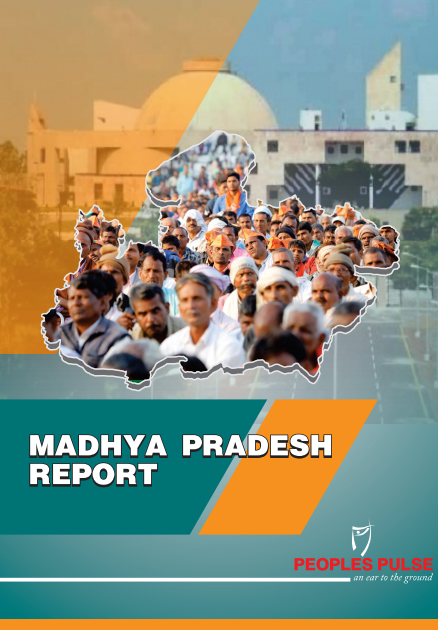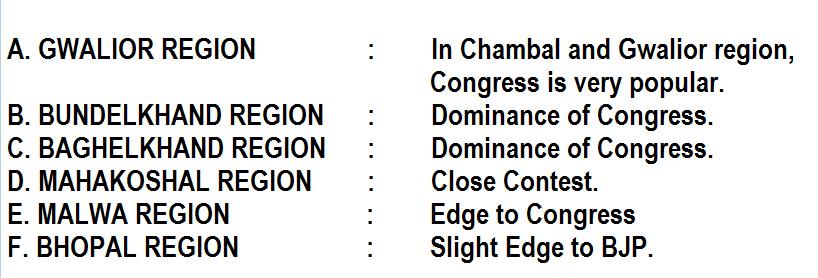Congress Enjoys Slight Edge In Madhya Pradesh: Peoples Pulse


After 15 years, Congress is all set to make a comeback in Madhya Pradesh by getting 116-120 seats in the 230-member Legislative Assembly. The BJP would get 98-102 seats. The mood for change is consistent in both rural and urban areas. In rural areas it is more pronounced.

SUBREGIONAL DYNAMICS
The survey showed that respective parties’ hold in the six different regions of the state. In most of the regions the BJP is suffering losses.

This is the outcome of a pre-poll survey conducted by Hyderabad based political research organisation, Peoples Pulse, between November 18-26, 2018. Ahead of this survey, Peoples Pulse, conducted a Mood Report in July 2018 for one month. The mood for change was evident then.
The report was compiled and prepared by Peoples Pulse senior associate Dr. Sajjan Kumar, a Ph.D from CPS, JNU and co-author of ‘Everyday Communalism’ published by Oxford University Press. The survey employed both qualitative and quantitative aspects of the people disposition.
The incumbent BJP is facing an undercurrent of anti-incumbency after ruling the state for 15 years since 2003. Anti-incumbency essentially revolves around the farmers’ anger across the state, thereby uniting the majority of upper castes and OBCs and a significant section of Dalits and tribes along their occupational identity instead of caste and ethnicity. Adding to the woes of the common man, even in urban areas, is the steep increase in the price of essential commodities like diesel and petrol that has a cascading effect into other sectors.
It must be noted that the incumbent BJP government led by C.M Shivraj Singh Chouhan tried its best by meticulously implementing policies and schemes customised for different sections, namely, women, children, Dalits, tribes and farmers. However, field insight suggests that the discontent with BJP government in the state outweigh the satisfaction, indicating a change of guard.
MODI A LIABILITY FOR THE BJP IN MP
Madhya Pradesh seems to indicate a reversal of the national mood wherein Modi was still considered an asset for the BJP. In fact, majority of the respondents who preferred to vote for change blamed Modi’s policies of demonetisation and inability to control the price rise of petrol and diesel for their woes. Many of them were soft on the Chief Minister and opined that Shivraj Singh Chauhan has to pay the price for Modi’s wrong policies. This sentiment was strongest among the farmers across the region.
FARMERS’ WOES BUILT THE MOMENTUM FOR CHANGE
Starting from Mandsaur incident since July 2017, wherein several protesting farmers demanding higher MSP for their crops were killed in police firing, Madhya Pradesh had the Congress go off the blocks to capitalise on their anger. Congress, despite its rampant factionalism succeeded in capturing the narrative of farmers’ woes as the prime electoral plank, thereby pushing the incumbent BJP on back foot. The BJP’s reaction to appeal to women and BPL especially the tribes, constituting around 21% of the state population, though diluted the momentum of change but couldn’t quite overcome it. The impact of long-term damage that farmers are facing after demonetisation and cashless payment system introduced in the Mandi still paints the rural narrative. However, it must be said that among the tribes the anger against BJP is considerably mitigated on account of intense welfare measures taken in the election year, particularly massive distribution of Pradhan Mantri Aawas Yojna and disbursal of Rs 1,000 per month into women’s accounts of families of the three tribes ~ Saharia, Baiga and Bharia. Similarly, despite the contesting protests around the SC-ST Act that witnessed protests by both Dalits and non-Dalits, the BSP has not emerged as the Dalits’ first choice even in areas adjoining Uttar Pradesh, considered to be stronghold of party. Rather, majority of Dalits prefer to go along the momentum of change by aligning with Congress on account of latter’s higher winnability quotient. Hence, in the final analysis, it’s the farmers’ woes and corresponding anger against the incumbent regime that happens to be the central narrative of the election.
BJP’s FAILURE TO BUILD AN ELECTION NARRATIVE
One of the central parameters to capture the voters’ imagination is to build and dominate the election narrative. At a time when Modi is no more an asset, the chief minister launched a blitzkrieg veering around himself targeting both Digvijay Singh and Jyotiraditya Sindhia. The terse advertisement ‘Maaf Karo Maharaj, Humara Neta Shivraj’ intended to compare BJP’s 15-year rule and achievement with the bad memories of Digvijay Singh’s era when the conditions of road and electricity was pathetic. Having brought in the gloomy scenario of Digvijay Singh’s era, the slogan wrongly intended to target the star campaigner of Congress, Jyotiraditya Scindia. To a majority of electorate, the slogan didn’t cut much ice as they were not in the mood the blame Scindia for the ills of the Digvijay Singh government. Also, at a time when peoples’ sufferings lie in the moment, referring to past regime’s failure, that too 15 years ago, didn’t have many takers. Further, targeting Scindia and placing him in the same league with Digvijay Singh appears to be a tactical mistake by the BJP, as the former enjoys huge popularity among the electorate. Most importantly, the party tried to subtly circumvent the farmer’s issue rather than engaging them. In the end, BJP kept on coming up with multiple ad-hoc responses rather than building a central narrative to plunge into the election.
CONGRESS’ SUCCESS TO KEEP FACTIONALISM WITHIN LIMITS
Factionalism, responsible for the Congress’ 15-years ouster from power, has been kept within limits now. This is to going in favour of the grand old party. Contrary to the wide media coverage of a verbal spat between Digvijay Singh and Jyotiraditya Scindia over ticket distribution, majority of the electorate across regions conceded that Congress managed to control its factionalism better this time by asking Digvijay Singh to maintain a low-profile thereby depriving BJP of the chance of playing the spectre of ex-CM as the Congress face. Having taken care of Digvijay Singh, the party informally divided the activity span of other two big leaders, namely Kamalnath and Scindia, to the respective regions wherein Kamalnath was more active in Mahakoshal region while the latter in the rest. Digvijay Singh, realising the strategy of BJP focused on the cadres rather than masses. Thus, in the popular narrative the sub-regions of Chambal, Gwalior, Bundelkhand and Baghelkhnad and Agar-Malva, pro-change electorates are swayed by Scindia while in Mahakoshal region Kamalnath enjoys an edge and in Nimar-Malwa region both seems to compete and contribute to the prospective fortune of the party, thereby managing factionalism in a healthy way.
NOT ALIGNING WITH ‘BSP’ TO HELP CONGRESS
Much against the hyped BSP factor denting the social support base of Congress, the electoral contest this time is so bipolar that it has relegated BSP to the margins. It was found that majority of the otherwise pro-BSP voters in constituencies bordering Uttar Pradesh are veering towards Congress because of the latter’s win perception. Also, the fact that unlike Uttar Pradesh, BSP doesn’t have a dedicated cadre or a pool of credible candidates. This indicates that the 5-plus percent of popular vote that party enjoys since 2003 is on account of contesting nearly all seats, rather than commanding a core-transferrable vote, is fluid contrary to the argument election pundits. In this backdrop, any alliance with BSP would have gone against the Congress on three counts.
First, the BSP was demanding most of the seats Chambal, Gwalior, Bundelkhand and Baghelkhand region. The momentum that one witnesses for the Congress across castes, would have been diluted on account of having a weak BSP candidate.
Second, the presence of a weaker BSP candidate would have split the centrality of farmer’s issue on account of the caste dynamics that the Dalit party would have infused because of the SC-ST Act controversy.
Third, the fact that the majority of Dalit voters were already aligned to Congress doesn’t leave much space for BSP to contribute to Congress’ electoral fortune.
‘JAYS’ TO BE A NON-ISSUE
Another factor considered going against the Congress is the tribal outfit, JAYS (Jai Adivasi Yuva Shakti) with presence in Jhabu-Ratlam and some parts of Nimar-Malva & Mahakoshal region. It has turned a non-issue as its founder Hiralal Alawa joined the Congress just ahead the elections thereby avoiding denting the Congress’ tribes base.
UPPER CASTES AND OBC’s AS FARMERS WHO ARE PRO-CHANGE
The most crucial electoral dynamics that this election offers is the shift of a significant section of core voters of BJP from upper castes and OBC’s because of prioritising farmer’s identity over caste. Therefore, despite an aggressive campaign by the BJP and Shivraj Singh Chauhan to appeal to preponderant OBC electorate by taking measures like organising ‘6 Pichhda Varg Mahakumbh’ in the election year and presenting himself as a simple son of the farmer against the ‘Maharajas’ (a reference to Scindia), the farmers identity is prevailing over the majority of electorates who are more inclined to vote as farmers rather than as upper castes or OBC’s.
CONCLUSION
The ground situation in Madhya Pradesh strongly indicates a change of guard. This is because of 15 years of anti-incumbency, suffering due to demonetisation, steep price rise, emergence of rural distress in general and farmers’ anger in particular, the dissatisfaction of government employees and the emerging alienation of unemployed youth. These negatives far outweigh the positive outreach that Shivraj Singh Chouhan-led BJP government is making to different sections of electorates through a web of customised welfare measures and policies.
Also Read: How Many Seats Will TRS, Congress Win In Telangana; Exit Poll Results Out
























